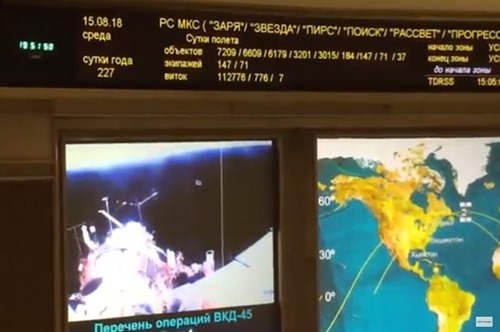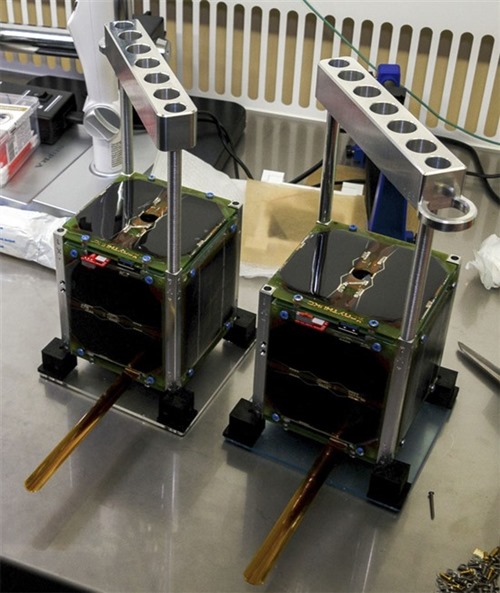Skolkovo satellites launched by cosmonauts during spacewalk
/The_satellite_launch.jpg)
Two nanosatellites made by Skolkovo Technopark resident Sputnix were recently launched into outer space by cosmonauts during a spacewalk from the International Space Station (ISS).
The two satellites, weighing 1.45 kilograms each, are carrying payloads of cosmic ray detectors that will help to research space weather such as solar wind. This can affect technology on Earth such as radio and radar, as well as satellites themselves that people rely on for weather forecasting and GPS. They were launched into open space by Russian cosmonauts Oleg Artemyev and Sergey Prokopiev during their planned spacewalk.
The satellites will now be flight-tested, and will confirm via radio channel their capabilities for stabilization and data acquisition and transmission. The Sputnix team will monitor the satellites from its control centre located at Skolkovo Technopark, an IASP member, and has installed a tracking antenna on the roof of the Technopark for this purpose. The research data and telemetry will be receivable via amateur radio ground stations all over the world.
Among those watching the launch with bated breath was a group of schoolchildren who had worked on the satellites at the Sirius centre for gifted children in Sochi, as part of a joint programme with the state space corporation Roscosmos. They assembled the satellites in collaboration with specialists from Sputnix using the OrbiCraft-Pro nanosatellite platform designed by the Skolkovo resident company.
Sputnix, which makes microsatellites, components and services, including Earth infrastructure for testing them, was founded in 2011. Four years ago, it built and launched Russia’s first private earth remote sensing satellite, the TableSat Aurora, using a microsatellite platform developed with the help of a grant from the Skolkovo Foundation. The company focuses closely on developing and creating equipment for schools and educational centres for training specialists in the aerospace industry.
/)



/canvascolor(0xffffffff)/2020_10_23_Spain_Malaga_TechPark_PTA.jpg)
/canvascolor(0xffffffff)/logo_TROKUT_Å_ibenik_PNG_2.png)
/canvascolor(0xffffffff)/Clipboard-2.jpg)
/canvascolor(0xffffffff)/ODTU_TEKNOKENT_logo_2016.png)
/canvascolor(0xffffffff)/MemberLogo-56301-60901.jpg)
/canvascolor(0xffffffff)/sosyokent-logo-eng_2.png)
/canvascolor(0xffffffff)/MemberLogo-43801-157601.jpg)
/canvascolor(0xffffffff)/RGB-InnlandetSciencePark-Ikon_1.jpg)
/canvascolor(0xffffffff)/2023_10_09_Brazil_PCT_UNICAMP.jpg)
/canvascolor(0xffffffff)/LOGO_PNT_EN_pelna_nazwa_(granatowe)_1.png)
/canvascolor(0xffffffff)/2021_01_26_Spain_PCT_Bizkaia.png)
/canvascolor(0xffffffff)/logotecnopole_alta_resolucion_1.jpg)
/canvascolor(0xffffffff)/2021_09_20_Thailand_STP_Chiang_Mai_University.jpg)
/canvascolor(0xffffffff)/Logo_TechPark-02_1.png)
/canvascolor(0xffffffff)/PNU_logo_7.png)
/canvascolor(0xffffffff)/2021_01_26_Spain_PCT_Gipuzkoa.png)
/canvascolor(0xffffffff)/Lion_scienc_park_black_trans_3.png)
/canvascolor(0xffffffff)/_______logo.png)
/canvascolor(0xffffffff)/Jinnovation_Park_logo.png)
/canvascolor(0xffffffff)/LOGO_KFUID_2.jpg)
/canvascolor(0xffffffff)/gcid-logo_logo-colour_for_web_with_20__2.jpg)
/canvascolor(0xffffffff)/2021_Spain_PCT__lava.png)
/canvascolor(0xffffffff)/LOGO-PC-TEC.png)
/canvascolor(0xffffffff)/2025_10_30_UAE_Sharjah_Research_Technology_and_Innovation_Park.jpg)
/canvascolor(0xffffffff)/2025_03_04_Germany_Ostfalen.png)
